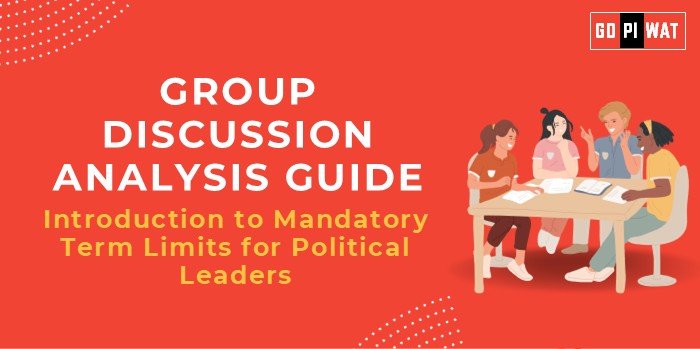📋 Group Discussion (GD) Analysis Guide: Mandatory Term Limits for Political Leaders
🌐 Introduction to Mandatory Term Limits
- 📖 Opening Context: Term limits for political leaders are widely debated as a mechanism to promote democratic accountability and prevent power monopolization. Globally, nations like the U.S. enforce limits on executive terms, while others like Germany and India allow indefinite re-election.
- 💡 Topic Background: The concept of term limits traces back to ancient Rome, where limitations aimed to curb tyranny. In modern times, term limits are seen as a safeguard against authoritarianism but are also critiqued for curbing experienced leadership. Recent debates around extended presidencies, like in Russia and China, have reignited this discussion.
📊 Quick Facts and Key Statistics
- 🌍 Global Prevalence: 90+ countries enforce term limits on heads of state (Freedom House, 2023).
- 🇺🇸 U.S. Example: Presidents can serve a maximum of 8 years across two terms.
- 🔄 Re-Election Dominance: Over 70% of long-term leaders stay in power by amending constitutions (World Bank, 2022).
- 📊 Democracy Index: Countries with enforced term limits score 15% higher on democratic health metrics (Economist Intelligence Unit, 2023).
👥 Stakeholders and Their Roles
- 🙋 Citizens: Demand transparent governance and avoid concentration of power.
- 🏛️ Political Leaders: Balance between legacy building and accountability.
- 📜 Constitutional Bodies: Frame and implement term-limit policies to uphold democratic principles.
- 🌐 International Observers: Monitor and encourage fair practices globally, especially in fragile democracies.
🏆 Achievements and Challenges
✨ Achievements:
- 🔒 Prevention of Power Monopolization: Ensures rotation in leadership and reduces risks of authoritarianism.
- ✅ Enhanced Accountability: Leaders prioritize short-term achievements within their limited tenure.
- 📊 Democratic Health: Evidence suggests nations with term limits experience lower corruption rates.
- 🌍 Global Examples: The U.S., South Korea, and Mexico effectively use term limits to sustain democratic transitions.
⚠️ Challenges:
- 💼 Loss of Experienced Leadership: Limits may remove skilled leaders prematurely.
- 📣 Populism Risk: Short-term tenure encourages focus on popularity over substantive reforms.
- 🏗️ Institutional Rigidity: Difficult to adapt to exceptional circumstances requiring extended leadership.
Global Comparisons:
- 🇨🇳 China: Lifetime tenure for leaders like Xi Jinping raises concerns about autocracy.
- 🇫🇷 France: Fixed two-term presidency ensures democratic transitions while maintaining strong leadership.
📚 Case Study: Rwanda’s constitutional amendment in 2015 enabled President Paul Kagame to extend his tenure, sparking debates on development versus democracy.
📄 Structured Arguments for Discussion
- 👍 Supporting Stance: “Mandatory term limits are essential to prevent power abuse and ensure democratic accountability.”
- 👎 Opposing Stance: “Leaders with proven track records should not be arbitrarily removed due to rigid term limits.”
- ⚖️ Balanced Perspective: “Term limits promote democracy but must be accompanied by institutional reforms to avoid unintended consequences.”
💬 Effective Discussion Approaches
- 🎯 Opening Approaches:
- 📊 Cite statistics: “90+ countries enforce term limits, reflecting their importance in curbing authoritarianism.”
- 💬 Pose a question: “Do term limits strengthen democracy or hinder it by discarding experienced leaders?”
- 🤝 Counter-Argument Handling:
- ✅ Acknowledge opposing views on leadership continuity but highlight successful transitions in nations like South Korea and the U.S.
🔎 Strategic Analysis of Strengths and Weaknesses
- 💪 Strengths: Reinforces democratic principles, encourages leadership diversity.
- ❌ Weaknesses: Limits on exceptional leaders, risk of ineffective successors.
- 🌟 Opportunities: Innovations in leadership strategies, stronger institutional frameworks.
- ⚠️ Threats: Political instability during transitions, risk of leaders manipulating term-limit laws.
🎓 Connecting with B-School Applications
- 🌍 Real-World Applications: The topic relates to corporate governance, decision-making frameworks, and leadership transitions, aligning with organizational change management themes.
- 📝 Sample Interview Questions:
- 💡 “How can term limits in politics be compared to succession planning in businesses?”
- 🔍 “Should democracies prioritize stability over term restrictions?”
- ✨ Insights for B-School Students:
- 📖 Study the impact of leadership change on governance efficiency.
- 🔎 Analyze term-limit policies for insights into organizational tenure frameworks.


